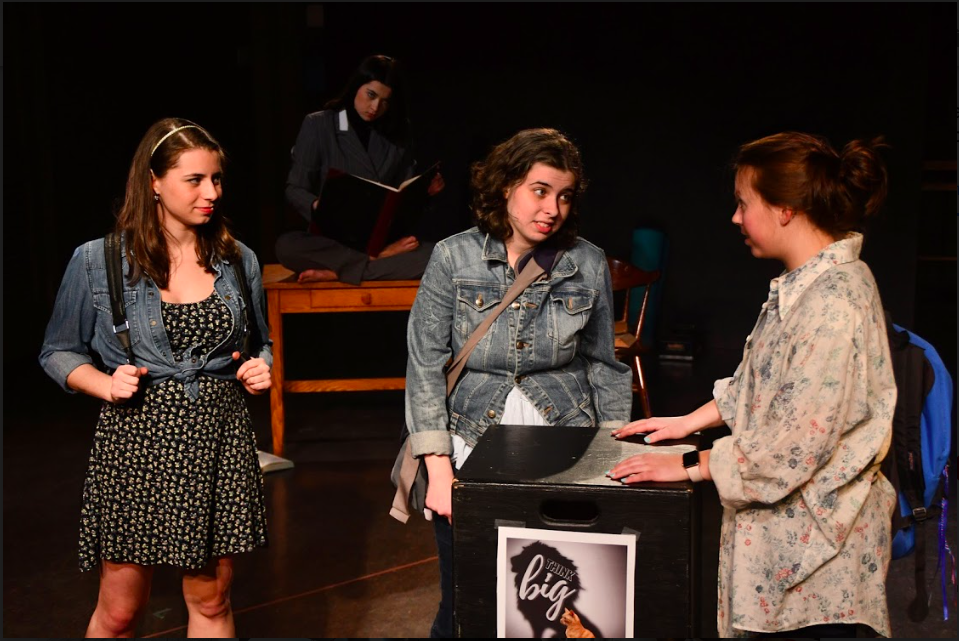In the cramped room 202 within Palmer Auditorium, audience members were transported to a familiar setting: high school hallways, where a love story unfolds. However, in this particular story, there is a supernatural twist. Written by Erin Fagan ’19 and directed by Fiona Noyes ’20, “Away with Words” tells the story of a senior named Hope, played by Colleen Feeney ’19. Hope is any average high school student in the sense that she has two amazing friends, Sam, played by Myrta Asplundh ’18, and Jamie, played by Julianna Goldfluss ’20. She also has a crush on Lydia, played by Jenna Berloni ’19. However, Hope has one secret that sets her apart: tattoos of words appear on her body to symbolize her “first words” at certain moments in her life, such as the first words she ever said or the first words that came out of her mouth after her eighteenth birthday. The story shifts between the perspective of Hope’s life and a supernatural world where the Editor, played by Sophie Bardos ’20, and the Assistant, played by Margot Weiss ’20, watch Hope’s life from a far and record it in a book. This Wig & Candle production was simple in terms of scenery, costumes, and props. But the humor and hidden meaning in the script, as well as the superb acting of all cast members, made me forget I was in an intimate setting rather than the grandeur of the main auditorium in Palmer.
In the first scene of the play, the audience meets Hope, Jamie, and Sam—all dressed in everyday high school attire. The audience remains initially in the dark about the identities of the two women lurking on the outskirts of the stage, sporting business suits and wearing no shoes. Carly Sponzo ’21 remarked that the lack of shoes “on the supernatural characters made them appear not grounded in this world.” The audience knows something is afoot, but it isn’t until Hope’s eighteenth birthday party that we are informed of her supernatural ability: tattoos of her “firsts” that appear on her body after significant life moments, and the role of the Assistant and Editor in Hope’s life.
After this plot reveal, the perspective switches to the Editor, played by Bardos in the first act and Noyes in the second act in the Saturday performance. Fagan used lighting to separate these two worlds; she explained that she “tried to make the editor’s world very cold,” while in contrast “Hope’s world [is] a little bit warmer.” Additionally, the worlds were separated by strategic positioning of props to create an invisible diagonal line splitting the stage in two sections. The Editor’s office was composed of a simple desk, several books, and a yoga mat against the wall, while a couch and tables distinguished the world of Hope.
The lines between Weiss and Bardos are fast-paced and humorous, making the audience burst into laughter on numerous occasions. Bardos lunges around her office and lays on her desk to stretch due to her new hobby of yoga, all adding to the comedic element of the show, while also making intense eye contact with the audience. Weiss brilliantly performs the frantic decisions her character must make in order to fix Hope’s world after finding out that the Editor purposely allowed for words to appear on Hope’s body, while still carrying the humor of the play at the same time. The fantastic performances of the characters of this now human world at times eclipse Hope’s storyline.
However, Feeney provides an equally brilliant performance. She perfectly portrays a shy girl crushing on someone who may not love her back, all the while dealing with a huge secret that cannot be explained. Feeney said in an interview that she related to Hope which helped her with her performance. The most intense and heartbreaking moment of the entire play is when Hope scratches at her forearm and stomach in desperation to remove the tattoos from her body. Feeney revealed that it was difficult for her to prepare for this scene and she had to psych herself up before going onstage. She said “there was lipstick under [her] nails and on [her] fingers” to indicate scratch marks. In addition, they used liquid collagen to emphasize the scarring from the scratch marks. The lights dim reflected the depression and loneliness into which Hope falls. At the end of this scene, I was worried that the play would have an unhappy ending, but by the end of the act two the characters received a happy ending: Hope and Lydia become a couple and the Assistant is promoted to Editor.
Although humorous, “Away with Words” also alludes to important themes such as language, mental illness, identity, and empathy. In the playbill for the show, under the director’s note, Noyes explains that this play is “a story about the power of language, both for good and for ill.” Sponzo felt the play achieved this goal as well as deal with self harm as Hope “undergoes the same symptoms of a mental disorder even when her condition is supernatural.” Through the character of Lydia, Fagan was able to play around with empathy – “she’s a very empathetic character” she said, “whereas Sam really struggles because she kind of sympathizes, but she doesn’t really get it,” and “has a lot of anger and frustration that kind of clouds her.” Feeney remarks that Noyes said the most important scene is at the end when Hope is fighting with Sam because, although Hope becomes Lydia’s girlfriend, the most important relationship for Hope is her friendship with Sam. Fagan wants to see more female representation, sexuality, and queer women in theatre, so she decided to make this happen at Conn. By all means did she achieve her goal, and more.









